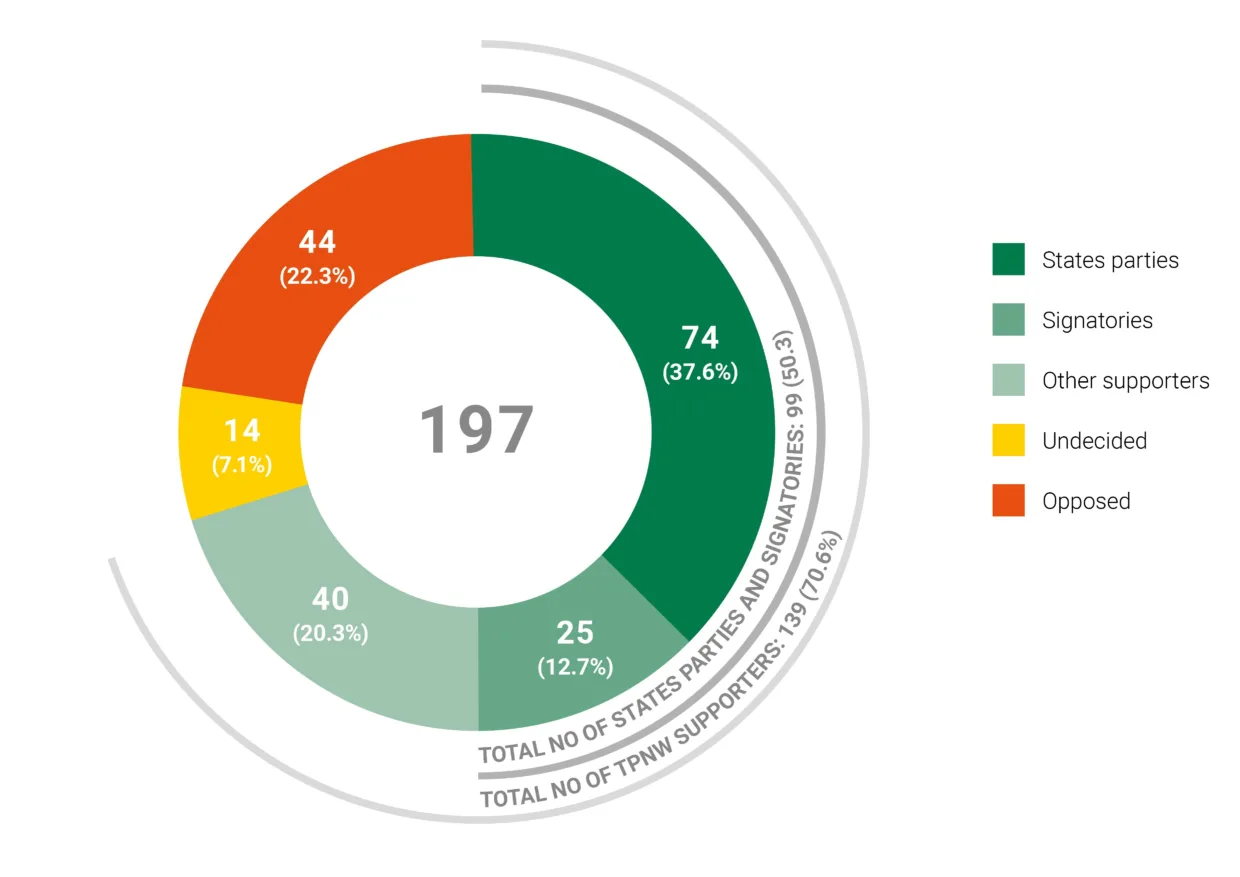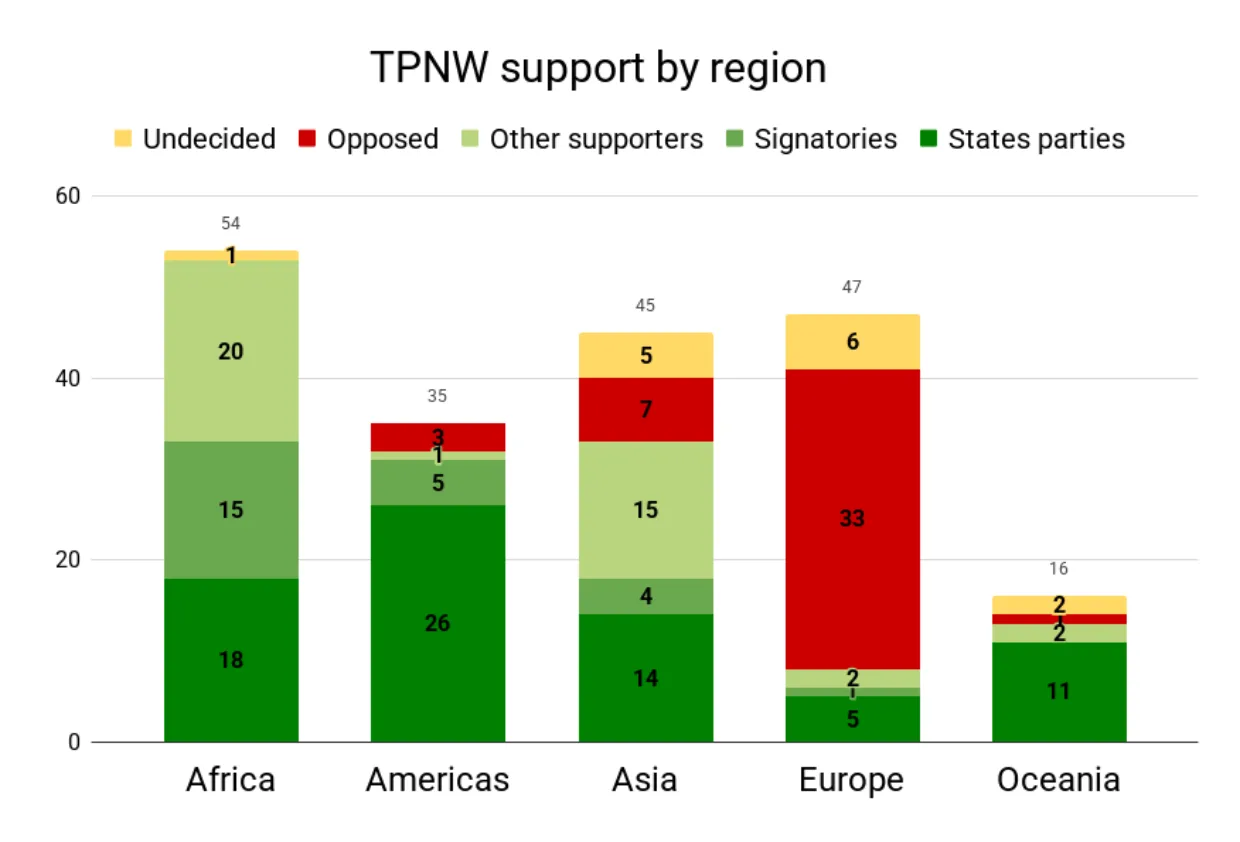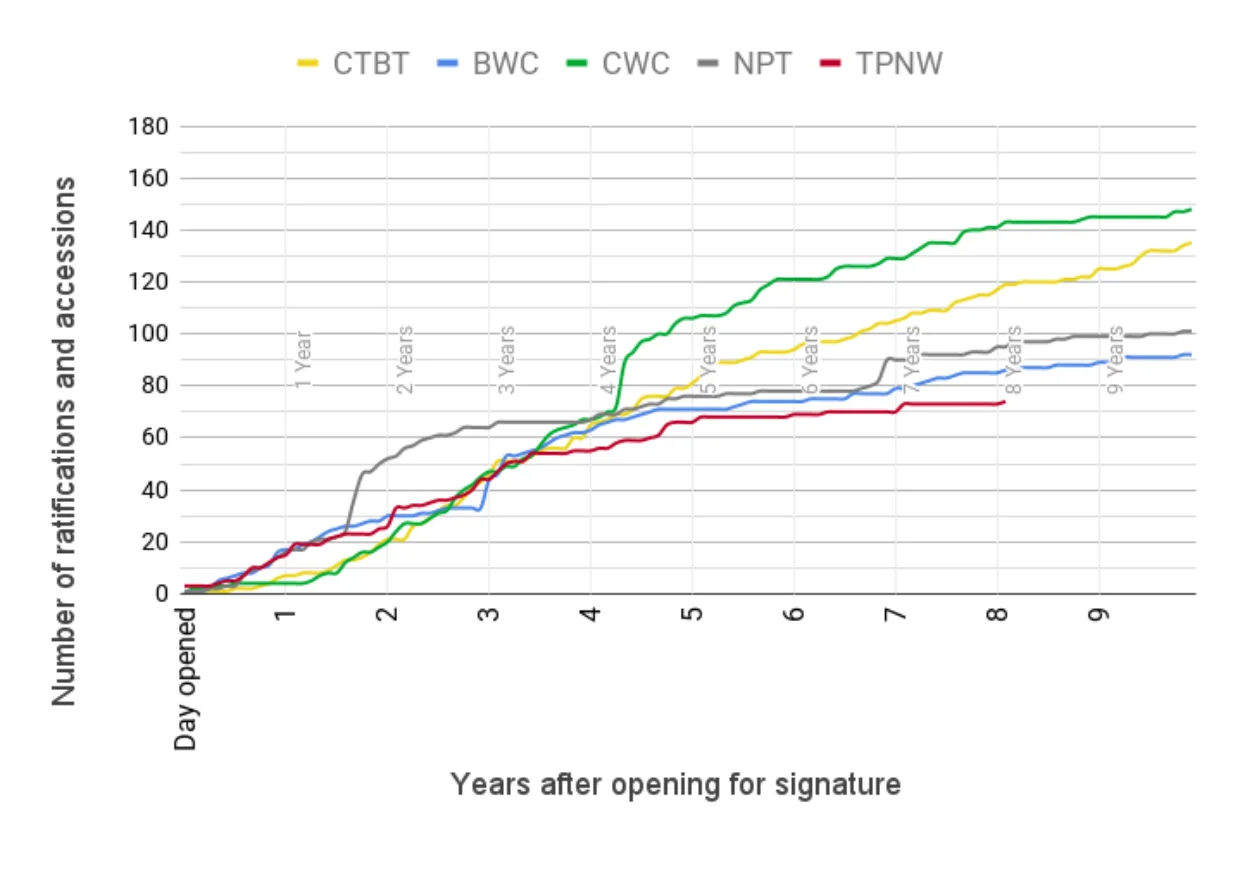The status of the TPNW
As of 26 September 2025, 99 states—more than half of the world’s total of 197—had firmly demonstrated their rejection of nuclear weapons and their political will for progress in nuclear disarmament by becoming states parties or signatories to the Treaty on the Prohibition of Nuclear Weapons (TPNW). Overall, the share of states supportive of the TPNW had increased to 70.6%, and close to 80% of the population living in the world’s 188 non-nuclear-armed states were represented by governments that support the TPNW.

No nuclear-armed state has yet adhered to the TPNW. But for every non-nuclear armed state that joins the TPNW, the Treaty gains influence. By signing and ratifying or by acceding to the TPNW, a state guarantees it will never develop nuclear weapons or embrace extended nuclear deterrence (and thereby appropriate the security case for nuclear weapons made so consistently by the nuclear-armed states and their umbrella states). In doing so, adhering states provide leadership and take action to create safety and stability, and reduce tension in a world where the danger of escalation of conflicts involving nuclear-armed states is a significant—and growing—concern.
A case in point is the TPNW’s new state party Indonesia, the fourth largest country in the world with rapidly growing influence and power. It is said to be ‘a key stabilizing force in the Indo-Pacific, playing a crucial role in reducing tensions between nuclear-armed states in the region’. Also the adherence to the TPNW in 2024 of the Solomon Islands—one of the smallest countries in the world—can be important for managing increasing tensions between the United States and China.
Seen in this light, it is difficult to understand the continued obstructionism of the TPNW by nuclear-armed states and some nuclear umbrella states. Progress for the TPNW should be acknowledged as being to the deep and abiding benefit of the collective security of humanity, including for the Treaty’s non-parties. After all, fear of a ‘proliferated planet’ of many tens of nuclear-armed states was a driving force of the Treaty on the Non-Proliferation of Nuclear Weapons (NPT) in the first place, and the TPNW takes forward that Treaty’s disarmament commitment.
States parties and signatories
As shown in the Figure above, the number of states parties to the TPNW had increased to 74 as of 26 December 2025, while 25 other states had signed but not yet ratified. Several signatory states reported that their domestic ratification processes were at an advanced stage – suggesting the potential for further significant progress on universalisation of the Treaty in 2025. This included Colombia, Djibouti, Ghana, Mozambique, and Zimbabwe.
Other supporters
A total of 98 states were not yet states parties or at least signatories to the TPNW at the end of September 2024. Forty of those, however, are identified by the Nuclear Weapons Ban Monitor as ‘other supporters’ of the Treaty, on the basis of their most recent voting record on the TPNW in the UN General Assembly. Thus, as of September 2025, the overall number of TPNW supportive states had reached 139 (or 70.6%). While they have not yet signed or adhered to the Treaty, these ‘other supporters’ have expressed their support to the TPNW by voting in favour (and in some cases also co-sponsoring) the annual UN General Assembly resolution on the TPNW. First introduced in 2018, the resolution calls upon all states that have not yet done so to sign, ratify, or accede to the Treaty ‘at the earliest possible date’.
Several of the 40 other supporters have already started domestic processes to sign or accede to the TPNW. Eight of the states in this category—Andorra, Egypt, Guinea, Iraq, Morocco, Qatar, Tunisia, and Yemen—participated as observers at the Second Meeting of States Parties to the TPNW (2MSP) in 2023.
Opposed states
The number of states opposed to the TPNW increased from 43 to 44 in 2024, when—after the election the year before of the right-wing populist Javier Milei as President—Argentina for the first time voted ‘no’ on the annual UN General Assembly resolution on the TPNW. Three other states with nuclear-free defence postures (Micronesia, Monaco, and Ukraine) also continued to vote ‘no’. As in previous years, it is largely, however, the nuclear-armed states and nuclear umbrella states that stand in the way of progress towards universalisation of the TPNW and agreement on nuclear disarmament, while continuing their nuclear-weapons-based defence postures that expose all states to unacceptable risk. All nine nuclear-armed states again voted against the annual UN General Assembly resolution on the TPNW. A further 31 of the 32 states which, at the close of 2024, had arrangements of extended nuclear deterrence with the United States (every one apart from Australia, which abstained) also voted ‘no’. Australia ended its opposition to the TPNW already in 2022. As in previous years, some of the opposed states were more conflicted on the TPNW than others.
Undecided states
The total of undecided states was reduced to 14 in September 2025, when Kyrgyzstan signed the treaty. The 14 undecided states are spread out across all continents, and include three umbrella states. As already mentioned, the category includes Australia, which is an ally of the United States. It also includes Armenia and Belarus – the only states with arrangements of extended nuclear deterrence with Russia. It should be noted that although Belarus meets the voting criteria set by the Nuclear Weapons Ban Monitor for inclusion in the undecided category with respect to the TPNW, its government most clearly demonstrates support for nuclear weapons.
The criteria for the Nuclear Weapons Ban Monitor’s categorisation of states by their position on the TPNW are explained in the Table below. For details about individual states, see the state profiles on this website.
Regional distribution of support
Breaking down all states’ positions on the TPNW by region, the figure below shows that support for the TPNW is high in all regions of the world apart from Europe, where 29 (or 85%) of the world’s 34 nuclear umbrella states are concentrated. The only five umbrella states located outside of Europe are Armenia, Australia, Canada, Japan, and South Korea. Three of the world’s nuclear-armed states are also located in Europe: France, Russia, and the United Kingdom. A total of 33 of the 47 states (70%) in Europe were opposed to the TPNW also in 2024. This included 23 of the 27 members of the European Union (EU). Europe stands out as a significant obstacle for further progress towards universalisation of the TPNW and agreement on nuclear disarmament. The EU should initiate processes to reflect on and address this. Europe has only five states parties: Austria, the Holy See, Ireland, Malta, and San Marino; and one signatory: Liechtenstein.
In Africa, all states but one—South Sudan—formally supported the TPNW in 2024, either as states parties or signatories, or as other supporters. South Sudan abstained on the annual UN General Assembly resolution on the TPNW in 2023 and did not vote in 2024.
The Americas is the region with the highest share of states parties. More than 74% of the states in the region are already states parties to the Treaty, while Argentina along with nuclear-armed United States and umbrella state Canada are the only opposed states in the region. In Oceania, too, the share of states parties is high, with 11 states parties (68%) among the 16 states in the region. Micronesia remains the only opposed state in this region, while umbrella state Australia along with the Marshall Islands are undecided.
In Asia, the five nuclear-armed states located in this region (China, India, Israel, North Korea, and Pakistan) were opposed to the TPNW also in 2024, together with US umbrella states Japan and the Republic of Korea (South Korea). Support for the TPNW, however, is relatively high also in Asia. A total of 33 of 45 states in the region (71%) are states parties, signatories, or other supporters.

Regional maps with distribution of support
Speed of adherence across WMD treaties
On 20 September 2025, the TPNW passed its eight year after opening for signature. The Figure below shows the speed of ratification and accession of the TPNW relative to the other key multilateral treaties in the legal architecture for WMD in the first 10 years after their opening for signature. As it shows, the TPNW fell behind the other treaties at approximately three-and-a-half years after opening for signature but then picked up more speed again after the COVID-19 pandemic. While still behind all of the other WMD treaties in numbers, the TPNW has since then largely followed the same trajectory of ratifications/accessions that the Biological Weapons Convention (BWC) and the Treaty on the Non-Proliferation of Nuclear Weapons (NPT) did at the equivalent point in time. This serves as a reminder that it took several years also for those treaties to accrue the authority that they have today.
